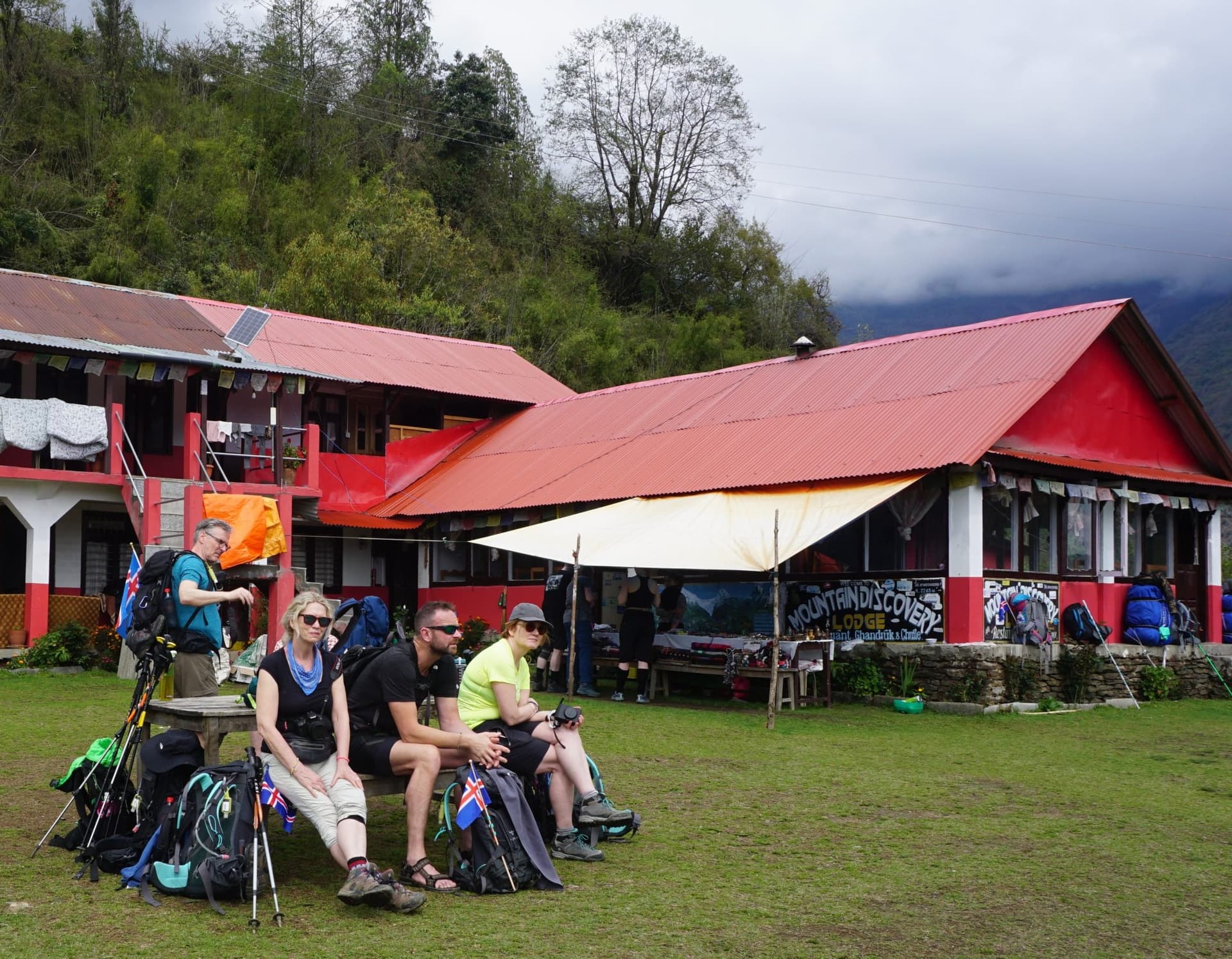Nepal is a country that is blessed with one of the most beautiful Himalayan terrains and sublime landscapes on the planet. Trekking in Everest region of Nepal is a famous adventure activity done by thousands of trekkers and travelers every year. With eight of the ten tallest mountain peaks in the world situated in the country, including Mount Everest- the tallest mountain on Earth, Nepal certainly does not lack in trekking destinations. The numerous trekking regions in Nepal all feature unique and exotic aspects and elements that make visiting the regions an exciting affair. Gorgeous Mountain views with wide open valleys and ethnic villages and settlements situated at the foothills of the Himalayas makes trekking in Nepal absolutely spectacular.
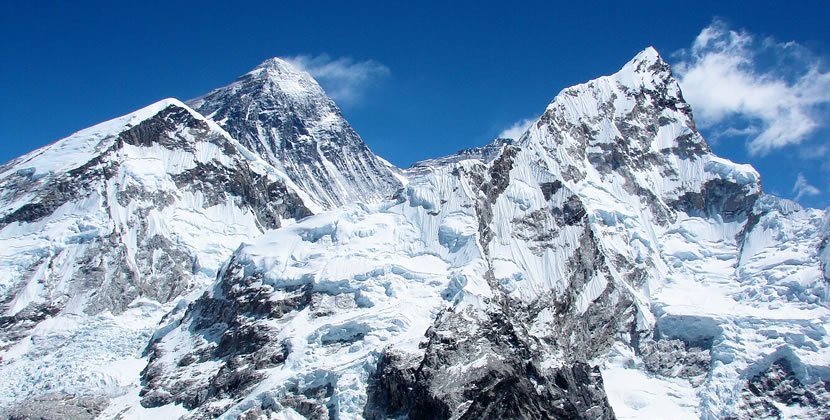
Among the many different destinations in the country, trekking in Everest region is the most sought after and the most popular. The Everest region, also known as the Khumbu region, is one of the most visited regions for trekking in Nepal. It is situated on northeastern Nepal on the Nepalese side of Mount Everest. The region is a major Sherpa settlement of the Himalayas and has an amazing mountainous landscape. Ranging in elevations from 3,300 meters (11,000 feet) to the 8,848 m (29,029 ft) summit of Mount Everest, the Everest region includes the famous Sagarmatha National Park and popular villages like Namche Bazaar and Tengboche. From the alarmingly dramatic airstrip at Lukla to the Base Camp of Mount Everest, the Everest region is a gorgeous cornucopia of Himalayan views and mesmerizing sights. Khumbu, with less than four thousand inhabitants, receives anything from ten to twenty thousand trekkers a year, and twice as many porters. With a very fragile environment, the Khumbu region is filled with many highlights and spectacular natural elements that range from mountains peaks, sapphire mountain lakes, glaciers, high passes and beautiful ethnic villages. Trekking in Everest region is a rich experience of immersing yourself in the unique amalgamation of Sherpa customs with amazingly diverse and wonderfully beautiful mountain landscape that comprises of the highest Himalayan range on the planet.
Facts about Trekking in Everest region
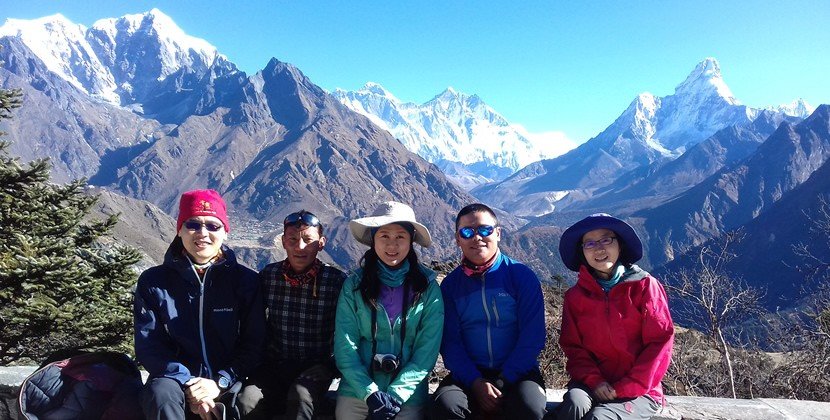
Located on the north-east of Nepal, Everest region is not only famous as a tourist destination for its scenic views of Mount Everest, but also for many other mountains that stretch across the region like the sharp white teeth of Charybdis from the famous epic of Odysseus. Trekking in Everest region pertains to trudging through the Sagarmatha National Park, established in 1976 and covering an area of 1148 square kilometers. Throughout the region, trekkers can encounter overwhelming views of unbelievable peaks, many Buddhist Gompas and chaityas and beautiful ethnic villages occupied by indigenous mountain people. The geography of Everest mostly includes rugged rocky valleys, alpine forests and meadows, amazing Sherpa villages, glaciers and icefalls. Adorned with breath-taking sceneries, trekking in Everest region is dominated by pine and hemlock woods in the lowlands and vast open mountain terrains and snow-covered acreages on the highlands. The majority of the people of this region are involved in mountaineering and tourism industry. It is a spectacular array of the most magnificent mountain peaks and Buddhist culture on Earth. Famous villages in the Khumbu region include Dingboche, Lobuche, Thame, Phakding and Monjo among many others. The Everest region is a sub region of the Solukhumbu district of the country. Trekking in Everest region is a well-known adventure holiday among trekkers.
Best time for trekking in Everest region
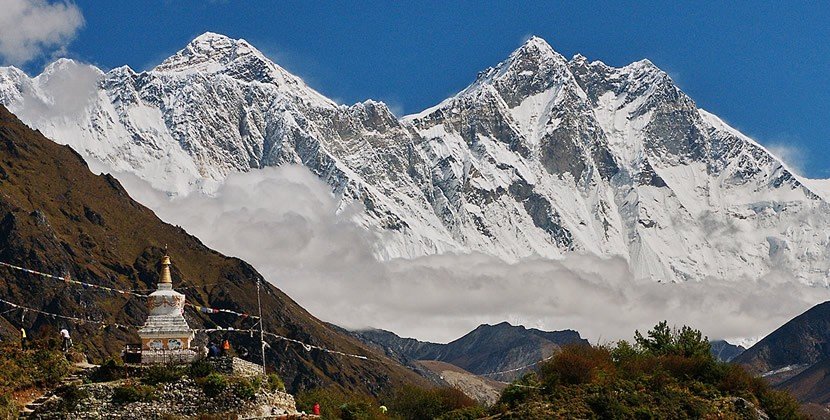
Trekking in Nepal can be done at all times of the year, but the most ideal time for trekking in Everest region would be during the spring season (March to May) and the autumn season (September to November). Between March and May, the weather begins to warm up and a whole range of Everest trekking options are available. Beautiful rhododendron and magnolia bloom in the mountains and the trekking trails become vibrant with lush vegetation and verdant woods. In the summer, from June to August, Nepal experiences the monsoon rains. Along with travel disruption, there are no clear mountain views, so trekking in Everest region during the summer isn’t as worthwhile. Autumn is the best time to visit the Everest region. With dry weather and crisp, clear skies, the mountain views are at their best. The countryside scenery at the mountains become green and flourishes resplendently following the summer monsoon. However, during this period, the popular trails become busy, and flights tend to book up quickly. In the winter, from December to February, the days are dry and cold, and high altitude places experience heavy snowfall and extreme cold weathers. Some high passes can be blocked by snow as well. Although a high-altitude trek may not be possible, winter can be a great time to visit Nepal nonetheless as there are fewer tourists.
Highlights of Trekking in Everest Region
.jpg)
Mount Everest
Mount Everest is known as Sagarmatha in Nepal and Chomolungma in Tibet. It is the highest mountain peak in the world with a height if 8,848 meters. A part of the Mahalangur Range, Mount Everest is referred to as “the Head of the Sky” and “the Goddess Mother of the World”. The world’s tallest Mountain Peak, Mount Everest is the epitome of grace and beauty. The international border between China and Nepal runs across Everest’s summit point. Mount Lhotse, Nuptse and Changtse are the nearby peaks of Mount Everest. First climbed in 1953 by Sir Edmund Hillary and Tenzing Norgay Sherpa, Mount Everest since then has become a famous destination in Nepal for trekking journeys, with thousands of trekkers doing treks in the Everest region every year. Named after Sir Gorge Everest, the mountain peak has two main climbing routes, one approaching the summit from the southeast in Nepal (known as the “standard route”) and the other from the north in Tibet. Over 60 million years old, Mount Everest comprises of different types of shale, limestone and marbles covered heavily by a thick blanket of snow. The peak of Mount Everest extends into the upper troposphere and penetrates the stratosphere; exposing it to the fast and freezing winds of the jet stream. Everest Base Camp Trekking is one of the most popular trekking journeys in Nepal, and the surge of trekkers doing the base camp trek to Mount Everest plays an exponential role in the tourism industry and revenue generation of the country.
Lukla Village
Lukla is usually the starting point of most trekking journeys in the Everest region. Situated at 2,860 meters, it is a popular place for visitors to the Himalayas near Mount Everest to arrive. Lukla translates to “place with goats” and the town contains a small airport servicing the region, and a variety of shops and lodges catering to tourists and trekkers, providing western-style meals and trail supplies. The Tenzing–Hillary Airport, also known as the Lukla Airport, is perhaps one of the most extreme airports in the world. The flight from Kathmandu to Lukla in itself is like an adventure where the plane flies around tall forested mountains and chartreuse hills. The reason the Lukla Airport and the flight to Lukla is considered dramatic is because there is high terrain immediately beyond the northern end of the runway of the airport and a steeply angled drop at the southern end of the runway that cascades down into the valley below.
Namche Bazaar
The town of Namche Bazaar is the most popular town of the Khumbu and is one of the most visited highlight of trekking in Everest region. Situated in the side of a mountain, Namche Bazaar is the home of many Sherpas. Immediately west of Namche is the Kongdi RI Himal, and to the east is the Thamserku Peak. Namche is also known as the “Gateway to the High Himalayas” and was an important trading point between Nepali and Tibetan traders in ancient times where the trade of dried meat, trinkets and cheese was done. On a hill overlooking Namche Bazaar is the Syangboche Airport that is no longer in use. Namche is famous for altitude acclimatization while trekking. The town has a number of lodgings and stores catering to the needs of visitors. On Saturday mornings, a weekly market is held in the center of the village, where the items for sale tend to be clothes, Chinese consumer goods, shoes, traditional trinkets, food, utensils and the likes. The famous Everest View Hotel- the highest-located hotel in the world lies a bit further from Namche. It is also called the commercial hub of the region and the town’s location on the side of the mountain results in its terrace-like topography. The town also has an Everest Photo Gallery and a Sherpa-Culture Museum. The Sherpa people in Nepal are a homogeneous and remarkably isolated population and Namche is a great place to really be immersed in the Sherpa culture. The sight of the local people wearing colorful traditional clothing is quite fascinating. The men wear long-sleeved robes called kitycow that falls slightly below the knee. Chhuba is tied at the waist with a cloth sash called kara, creating a pouch-like space called tolungwhich can be used for storing and carrying small items. Traditionally, chhuba were made from thick home-spun wool, or a variant called lokpa made from sheepskin. Chhuba are worn over raatuk, a blouse (traditionally made out of bure, white raw silk), trousers called kanam, and an outer jacket called tetung. The Sherpa women traditionally wear long-sleeved floor-length dresses of thick wool called tongkok. A sleeveless variation called angi is worn over a raatuk (blouse) in warmer weather. These are worn with colorful striped aprons; metil aprons are worn in front, and gewe in back, and are held together by an embossed silver buckle called kyetig. Namche Bazaar is a great place to observe the mountain-people’s customs and rituals and to experience Nepal’s exotic multi-culturalism.
Tengboche
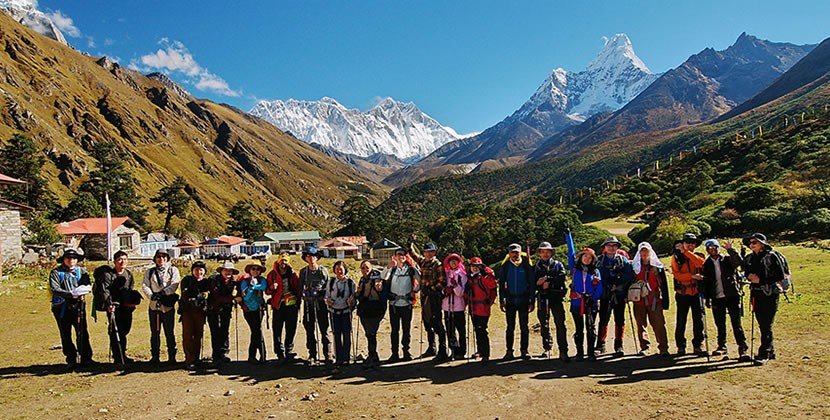
Another popular village in Khumjung in the Khumbu region, Tengboche is considered the spiritual hub of the region as the Tengboche Monastery, which is visited by trekkers and climbers to receive blessing for a successful journey, is located here. The Tengboche Monastery is the largest monastery of the region. Tengboche offers a panoramic view of the Himalayan Mountains, including the well-known peaks of Tawache, Everest, Nuptse, Lhotse, Ama Dablam, and Thamserku. Tengboche is located on a hill at the confluence of the Dudh Koshi and the Imja Khola Rivers. Tengboche is a midway station on the trail to the base camp for the mountain climbers of Mount Everest and other peaks of over 8,000 meters. The areas form part of the entire Khumbu region up to Tibet border, encompassing Sagarmatha National Park. The monastery is also strategically placed on the way to Everest base camp and thus attracts large number of tourists from all parts of the world. During the spring season, hill slopes around Tengboche are covered with beautiful flowering rhododendrons. Tengboche is also one of the oldest Sherpa settlements of the Everest region. Apart from the clean pristine mountain air and lush green surroundings of the Tengboche Monastery and the mountain views, it is also the host to the celebration of the jovial Mani Rimdu festival that takes place during the month of October. The village also exhibits an important part of Nepal’s heritage. In the tranquility of the ancient forests surrounding Tengboche, Nepal’s national bird- the iridescent Danphe can seen roosting on the trees while huge vultures dominate the blue skies above. The wild places of the village are also a home to Himalayan Thars and Antelopes, as well as the elusive and endangered Musk Deer. During cold winters as the sun’s rays illuminate the Himalayan surrounding, the sight of Nuptse and the peaks of Ama Dablam and Mount Everest seem to glow when seen from the hill at Tengboche. The ethereal sight of the glowing mountain peaks is something that is indescribable.
Kalapatthar
“Kalapatthar” means “Black Rock” in Nepali and is a notable landmark located on the southern ridge of Pumori in the Nepalese Himalayas above Gorakshep. The ascent of Kalapatthar is very popular with trekkers in the region of Mount Everest since it provides the most accessible close up view of Everest. The views of Everest, Nuptse and Changtse are spectacular from Kala Patthar and there are glimpses of the northern flank and summit of Lhotse as well. Most experienced trekkers claim that the Base Camp of Everest isn’t even the main highlight of the trekking journey in terms of Himalayan visuals, that aspect belongs to Kalapatthar. Hiking to Kalapatthar in the very early hours of dawn to see the sunrise amidst the Everest massif is one of the most beautiful experiences of one’s life. Despite everything we’re told about sunrises being cliché and overrated, nothing beats the absolute euphoria and melancholia of watching the sun rising amidst the cerulean mountains and sweeping the peak’s with its glorious rays, turning the tincture of the mountains from silvery white to a cascade of molten gold and burning ember.
The Gokyo Lakes
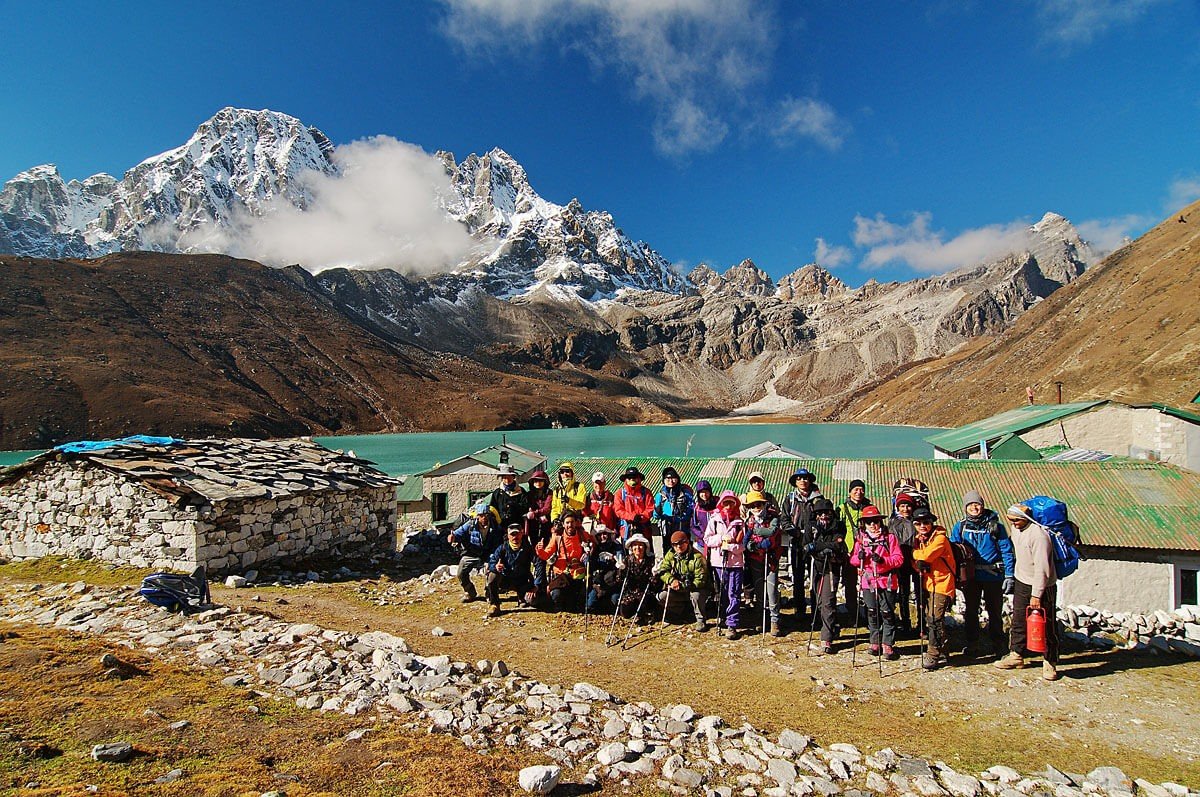
The Gokyo Lakes are the world’s highest located oligotrophic freshwater lake systems in the world. Comprising of 19 lakes with six major lakes, the Gokyo Lakes are located at an altitude of 4,700 to 5000 meters. The six major lakes of Gokyo are the Gokyo Cho, the Gyazumpa Cho, the Tanjung Cho, the Ngozumpa Cho, the Thonak Cho and the Longpanga Cho. Among these six, the Gokyo Cho (also called the “Dudh Pokhari”, which translates as “the lake of Milk” in Nepali) is the main one. The village of Gokyo lies on its eastern shores. The Thonak Cho is the largest among the six and the Longponga Cho is the first lake that comes into view during the trek to the Gokyo RI. Hiking to Gokyo RI is a more scenic trekking route than regular base camp trekking because the mountain top of the Gokyo RI offers a spectacular panoramic view of the five tallest mountains in the world- Mount Everest, Kanchenjunga, Mount Lhotse, Mount Makalu and Mount Cho Oyu. Other mountains like Nuptse, Ama Dablam, Thamserku, Pumori, Kangtega, Taboche, Cholatse and Khumbila can also be seen. The Gokyo Lakes are considered sacred by both Hindu and Buddhist people. Every year, hundreds of Hindu pilgrims visit the lakes and take a holy bath in the lake’s waters during the Janai Purnima festivals. It is believed that the lakes are the residing abodes of the Nag Devata- the Snake Gods. The topaz waters of the Himalayan Gokyo Lakes are a home to many beautiful Brahminy Ducks and Himalayan Buzzards. The sight of the turquoise lakes on the foot of the Himalayas surrounded by lightly rolling brume and a peaceful environment presents people with an other-worldly feel. The angelic ambiances of the Gokyo Lakes are extremely aesthetically pleasing.
Other Highlights of Trekking in Everest region include:
Crossing High Passes
Like the Kongma La Pass, the Cho La Pass and the Renjo La Pass among others. The High Passes are paths that go through high elevated grounds and offer a spectacular view of the entire terrain. High Passes are also a regular trail used by the local people to move their herds of sheep and mountain goats to different pasturelands. In the winter when snowfall becomes quite heavy, the High Passes tend to be blocked because of high accumulation of snow.
The Glaciers:
That grace the Everest region. The region has many glacial flow through its mountain terrain, like the Amphu Lapcha Glacier, the Hinku Glacier, the Imja Glacier, the Khumbu Glacier, the Nangpai Gosum Glacier and the Ngozumpa Glacier among others. The Amphu Lapcha Glacier adjoins the Imja Glacier to its south and together with the Lhotse Shar Glacier and the Imja Glacier; it forms the three major glaciers in the region. The Imja glacier on the other hand, originates from the western face of Kali Himal and skirts the southern slopes of Imja Tse (Island Peak). The Khumbu Glacier is the world’s highest located glacier with an elevation of 4,900 meters at its terminus to 7,600 meters at its source. The Khumbu Glacier is followed for the final part of the trail to the Everest Base Camp Trek. The glacier also has a large icefall, the Khumbu Icefall, at its west end. The Khumbu Glacier is also the largest Glacier of Nepal, while the Ngozumpa Glacier, situated below Cho Oyu- the sixth highest mountain in the world, is the longest glacier in the Himalayas.
Peak Climbing:
In the Everest region. Classified by Nepal Mountaineering Association, the Trekking Peaks of the region generally fall under the 5,000 meter to 7,000 meter of elevation range. Various peaks can be attempted as part of a normal trekking trip leading up to the designated summit, like the Island Peak, the Mera Peak and the Lobuche Peak among many others. Mera peak is the highest trekking peak in the region and is also the easiest to climb. Likewise, the Island Peak lies between the peaks of Ama Dablam and Lhotse Himal and looks like island surrounded by the glacial sludge.
The Sagarmatha National Park:
the country's first national park inscribed as a Natural World Heritage Site. Trekking in Everest region generally includes trekking through the national park’s forests and enjoying its natural perseverance and protection of the region’s floral and faunal life. The Sagarmatha National Park has an exceptional area within its parameters and it covers most of the dramatic mountains of the region, glaciers and deep valleys. Dominated by Mount Everest, the Sagarmatha National Park is a home to several rare species of animals like the Snow Leopard and the Red Panda. The area of the national park represents a major stage of the Earth’s evolutionary history and is one of the most geologically interesting regions in the world with high, young mountains and glaciers creating awe-inspiring landscapes and dominated by the high peaks and coruscating deep-incised valleys. The park contains the world’s highest feature of biodiversity intricately blended with the region’s rich Sherpa culture.



